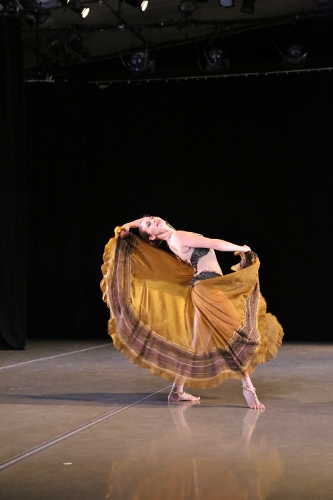|
 |
|
|
 |
 |
For its New York season, June 1-4, Graham 2 presented nine sparkling gems: a series of solos from modern dance pioneers, duets and excerpts from the Graham canon and a world premiere created for the dancers. Graham 2 is a pre-professional dance company which showcases the top students of the Martha Graham School. It was established in 1983 by renowned Graham dancer Yuriko at the behest of Graham; 85% of the current Company began as members of Graham 2. The gifted group included 11 dancers and an apprentice; guest dancer Alessio Crognale; and three guest students from the Full Time Program. As Virginie Mécène, Artistic Director of Graham 2, said, “We are bringing audiences outstanding works from the past and present performed by dancers of the future.” It was first-rate. The program June 2 at the Martha Graham Studio Theater began with an excerpt from “Secular Games: I. Play with thought-on a Socratic Island” (1962), choreographed by Graham, highlighted the athleticism of the five male dancers. They each gave a solid solo turn handling a large soft ball for synchronizing turns, leaps and tossing it about with ease. The solo “Serenata Morisca” (Moorish Serenade) (1916) was created for Graham by dance pioneer Ted Shawn, who recognized her exceptional talent (she was 22). The movements displayed Shawn’s signature orientalist style, fused with early modern dance. Karlie Budge performed with elegant lines, spirit, coquettishness, exquisite upper torso and foot work, aided by a wide skirt, bare midriff and crop top, bells on her ankles and a red rose in her hair. Choreographer Stuart Hodes flew seven bombing missions during World War II, among other piloting assignments. After the war, he studied dance and was a Graham dancer until 1958. His “FLAK” (1951) is a German acronym for Fleiger Abwehr Kanonen, or anti-aircraft fire. The piece lasts two minutes and nine seconds, the length of many a WWII bomb run. Wearing a jumpsuit, soloist Jean-Baptiste Ferreira epitomized the anxiety and fear of this experience with shaking and fast, sharp and airborne movements with outstretched arms, like the wings of a plane. Béla Bartók’s dissonant, driving “The Chase” enhanced the haunting performance. “En Dolor” (In Pain) (1944) was choreographed by then 19-year-old Ethel Winter, and has been described as “a lament of memory.” The solo, inspired by the Spanish Civil War, relates the pain of personal loss, coping with the grief and anger and finding strength to get passed it. Sabrina Lobner took charge of portraying all these emotional stages: slow movements, stomps, hips sliding from side to side, strong balancing holds and focus of purpose. “Dream Voyages” (1996) is one of Pearl Lang’s later works, in collaboration with Kevin Predmore. It explores the dark and anxious state of mind transitioning between sleep and wakefulness, during hypnagogia. This phase is characterized by lucid thought and dreaming, hallucinations and sleep paralysis. Octave Parfait did a masterful job of portraying a man on the verge: lying on a bed-size spotlight on the floor, twisting, rolling, tortured. Then screaming face, left arm stuck in his unitard to extricate, hard landing leaps. A most beautiful visual: a long piece of white silk fabric attached to a pole became a sail, which Parfait floated across the room, describing an array of curving shapes. He covered his face and parts of his body with it, he walked like a blind person, he wrapped himself in it. A riveting piece. Two duets showed Graham’s lyrical side. “Stars” and “Moon” from “Canticle for Innocent Comedians” (1952), staged by Mécène, featured wonderful duets by Carley Marholin and Giacomo Bavutti in the former and Cara McManus and Richardo Barrett in the latter, executing unique lifts, carries and smooth transitions. Guest choreographer Adam Barruch created “The Moon Borrows the Sun’s Light (world premiere) for the Graham 2 dancers. The program notes tell us that the moon and body are originally pure yin; they must borrow yang from another source to become yang. The “yang of other” is the primordial open unified energy. Which leads to fine choreography—intertwining bodies, lots of quick arm and hand movements and shapes. The two excerpts which comprised Graham’s “Plain of Prayer” (1968), staged by Mécène, were evocative of the Tibetan place of prayer, where the devoted come to seek solace, ask for what they want and need and learn what is truly worth having. Bare-chested men in white harem pants prostrated, kneeled, whirled, and leaped grandly, and by the end, lifted and carried the sari-clad goddess-like Budge. Barrett, bare-chested in red harem pants, a powerhouse dancer to watch, partnered with Budge for exquisite duets. Graham’s “Prelude to Action” from “Chronicle” (1936): “Unity—Pledge to the Future” was reconstructed by Sophie Maslow and others from film clips and Barbara Morgan’s photographs. It doesn’t depict the realities of war but abstracts the effects it leaves on one’s psyche. The movements, embodying classic Graham, including contraction-release, are strong and fast. The all-women cast, garbed in black, danced in unison in a line and circles, ran across the stage, expanded their chests, spread out their arms, did somersaults, matching Wallingford Riegger’s muscular music. The majestic Sierra K. Powell, in a white dress, took on the Graham solo role as the strong figure that unites them and gives them hope.
 Carley Marholin and Giacomo Bavutti in Martha Graham’s Stars duet from "Canticle for Innocent Comedians" Photo © & courtesy of Melissa Sherwood |
|
 Sabrina Lobner in Ethel Winter’s "En Dolor." Photo © & courtesy of Melissa Sherwood |
|
 Octave Parfait in Peal Lang’s "Dream Voyages." Photo © & courtesy of Melissa Sherwood |
|
 Jean-Baptiste Ferreira in Stuart Hodes’ "FLAK." Photo © & courtesy of Melissa Sherwood |
|
 Karlie Budge in Ted Shawn’s "Serenata Morisca." Photo © & courtesy of Melissa Sherwood |
|
|
|






